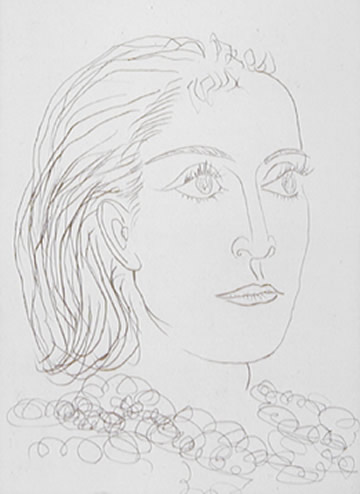 This
delicate and linear drypoint etching
This
delicate and linear drypoint etching  This
delicate and linear drypoint etching Portrait
of Dora Marr (state III) was created August
16, 1937.
This
delicate and linear drypoint etching Portrait
of Dora Marr (state III) was created August
16, 1937. The story of Dora Maar’s relationship with Picasso is legendary in the history of 20th century art. Picasso met Maar, the Surrealist photographer, in the fall of 1935 and was enchanted by the young woman’s powerful sense of self and commanding presence. Although still involved with Marie-Thérèse Walter and still married to Olga Khokhlova at the time, Picasso became intimately involved with Maar by the end of the year, and by 1937 she had ascended to the status of the artist's primary mistress. Unlike the docile and domestic Marie-Thérèse who had given birth to their daughter Maya in 1935, Maar was an artist, spoke Picasso’s native Spanish, and shared his intellectual and political concerns. She even assisted with the execution of the monumental Guernica and produced the only photo-documentary of the work in progress. A nd as she was one of the most influential figures in his life during this time, she also became his primary model. Looking back on the pictures that he painted of her, Picasso once admitted that Dora Maar had become for him the personification of the war. Her image, which he reinterpreted countless times between 1937 and 1944, embodied all of the complicated and conflicting emotions of life in the midst of occupied Paris. But what first caught Picasso's attention was Maar's transfixing beauty ... which James Lord described upon meeting Maar in 1944: "Her gaze possessed remarkable radiance but could also be very hard. I observed that she was beautiful, with a strong, straight nose, perfect scarlet lips, the chin firm, the jaw a trifle heavy and the more forceful for being so, rich chestnut hair drawn smoothly back, and eyelashes like the furred antennae of moths" (James Lord, Picasso and Dora, New York, 1993, p. 31).
More than most of the women in his life thus far, Dora Maar was
Picasso's intellectual equal – a characteristic that the artist found
both stimulating and challenging. During the occupation and as tension
mounted in their relationship Picasso would express his frustration by
furiously abstracting her image, often portraying her in tears.